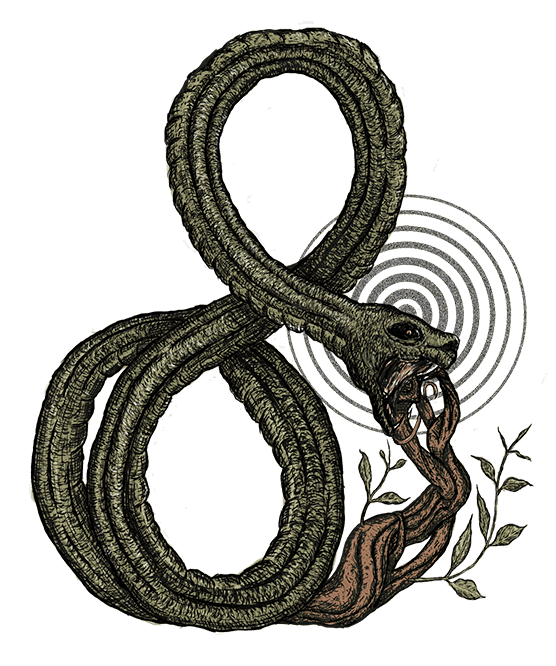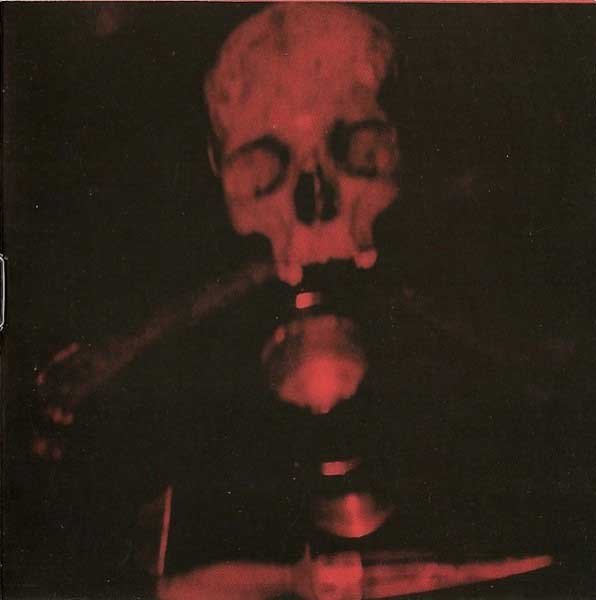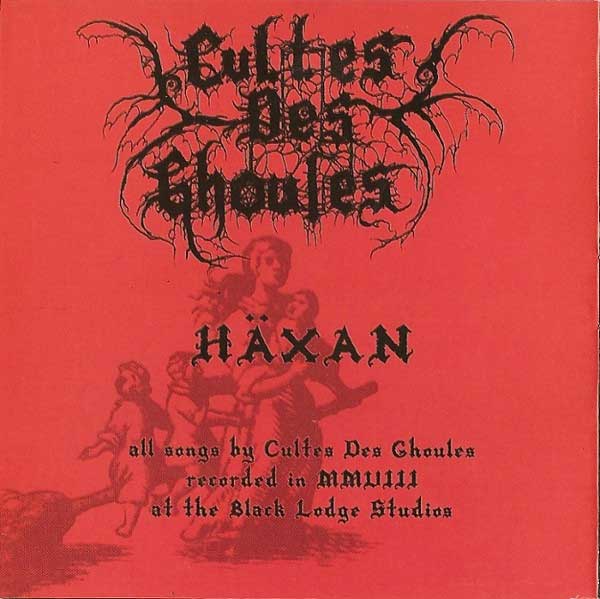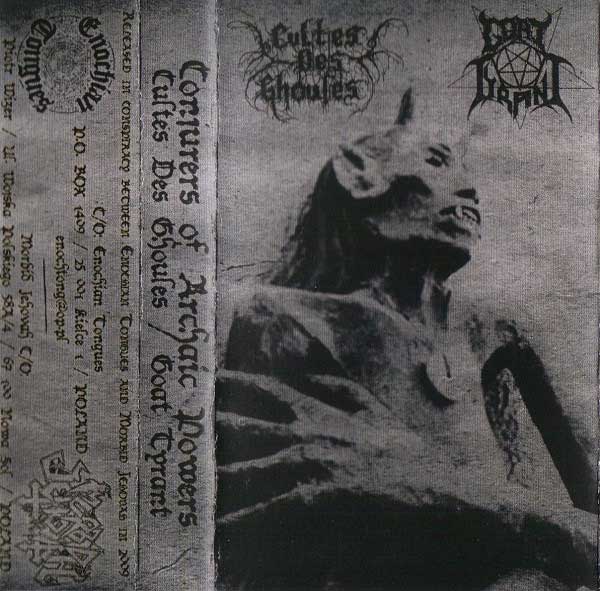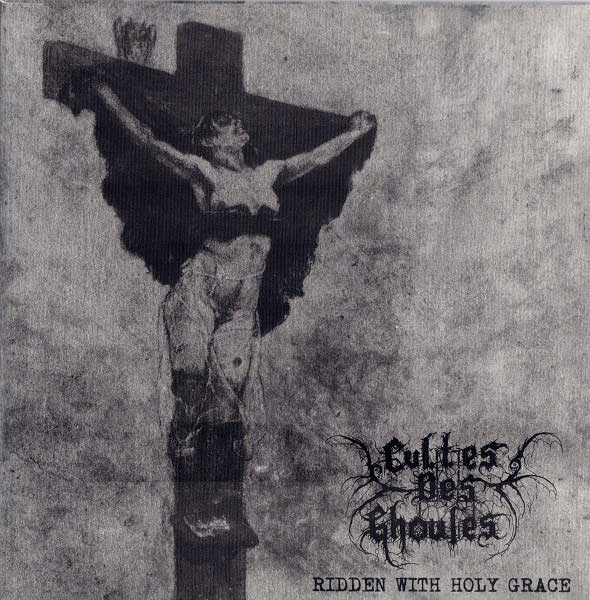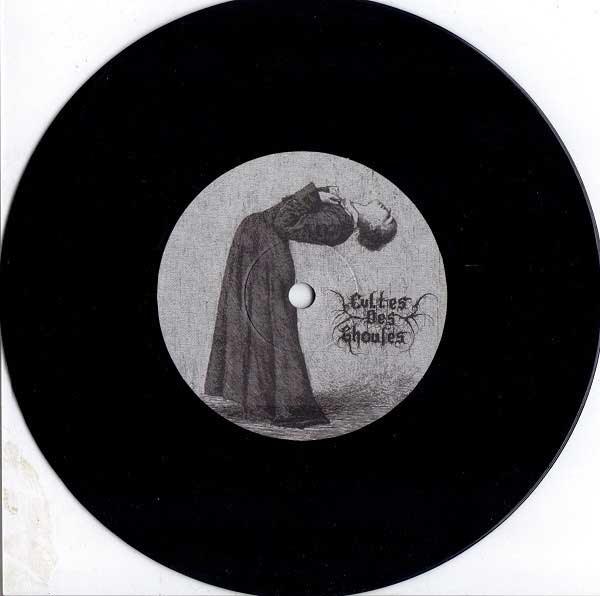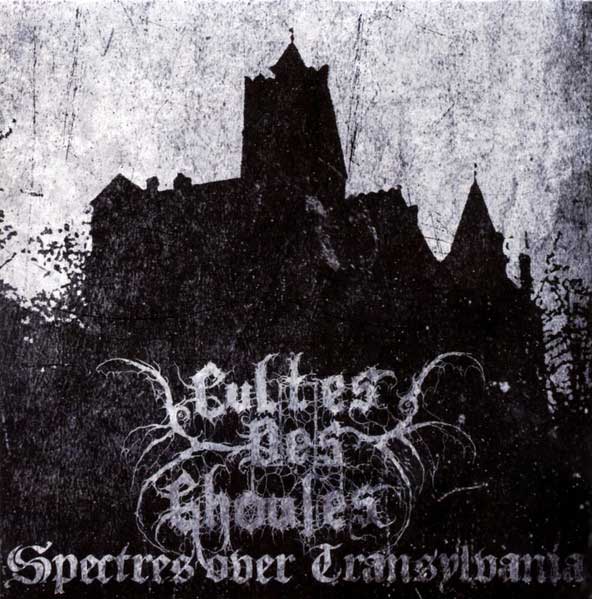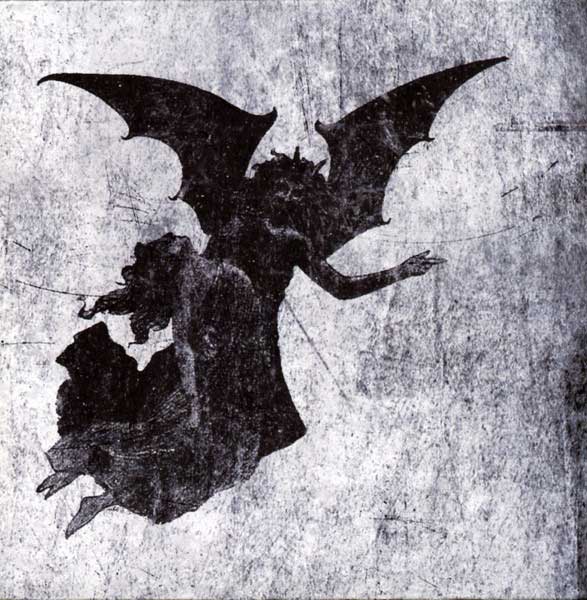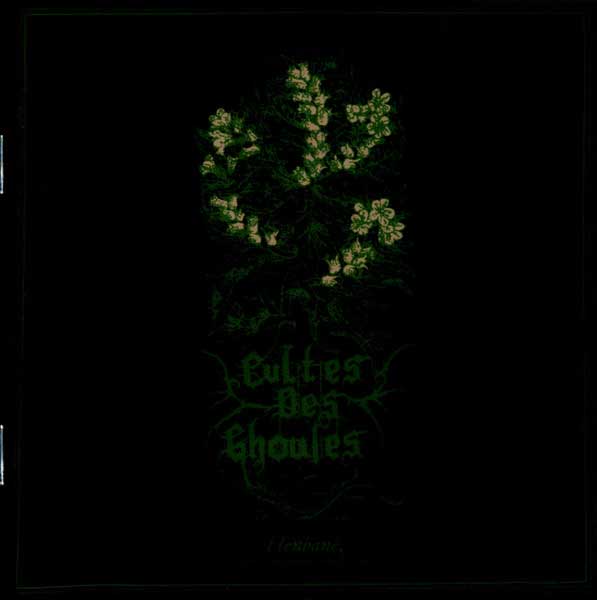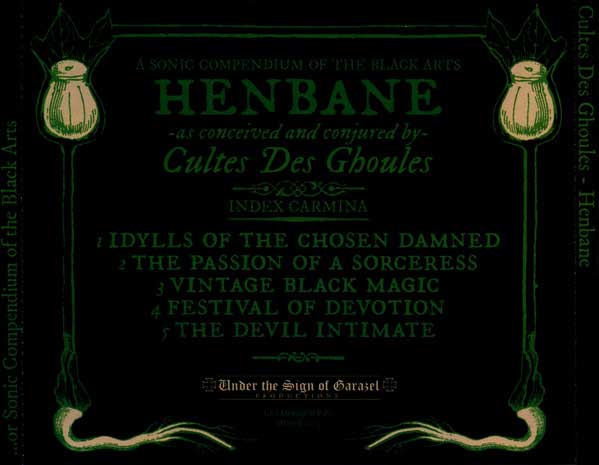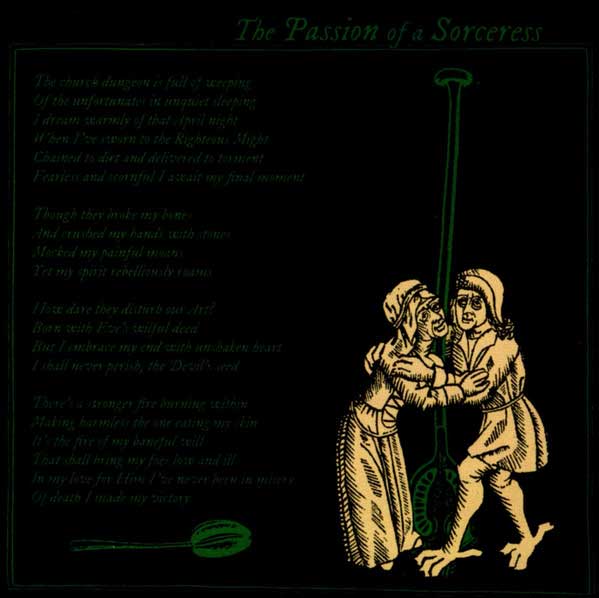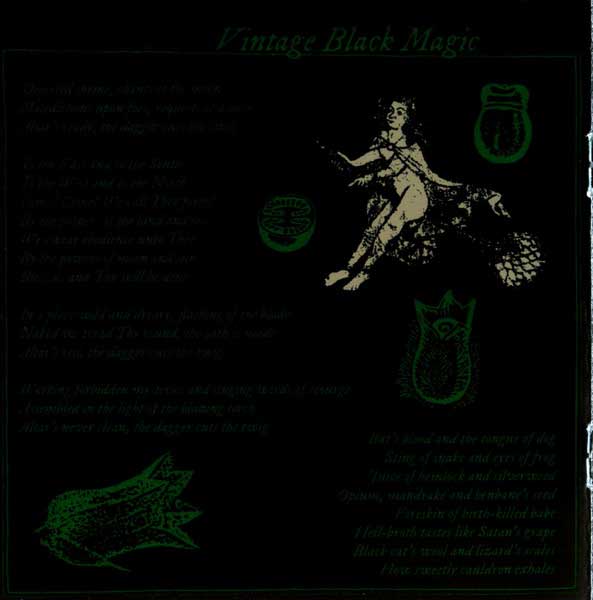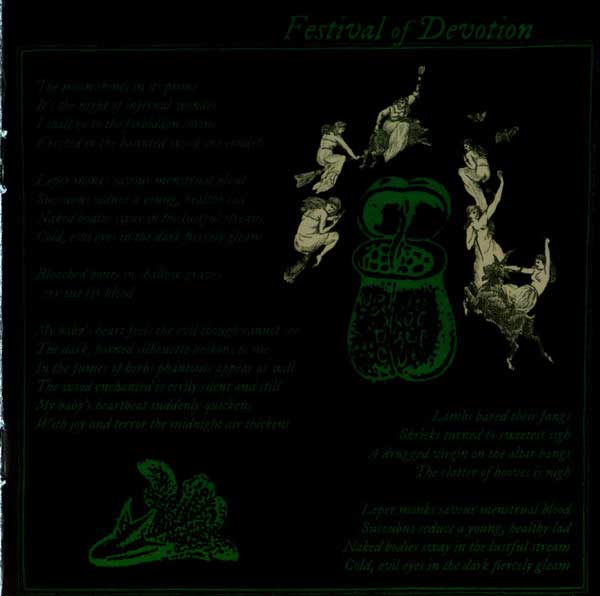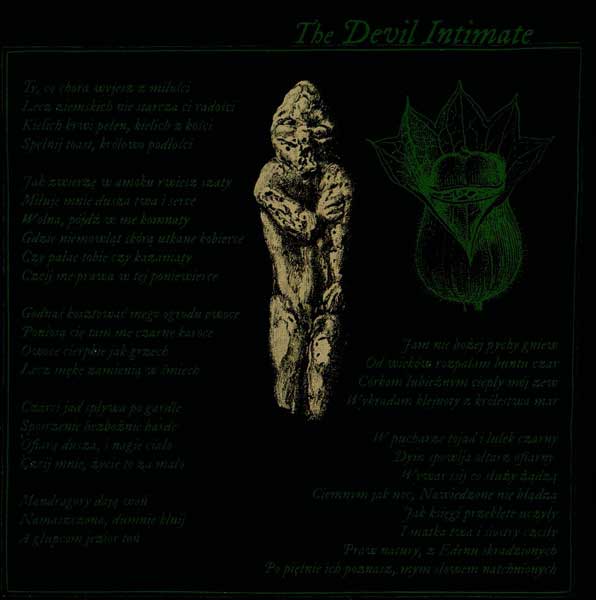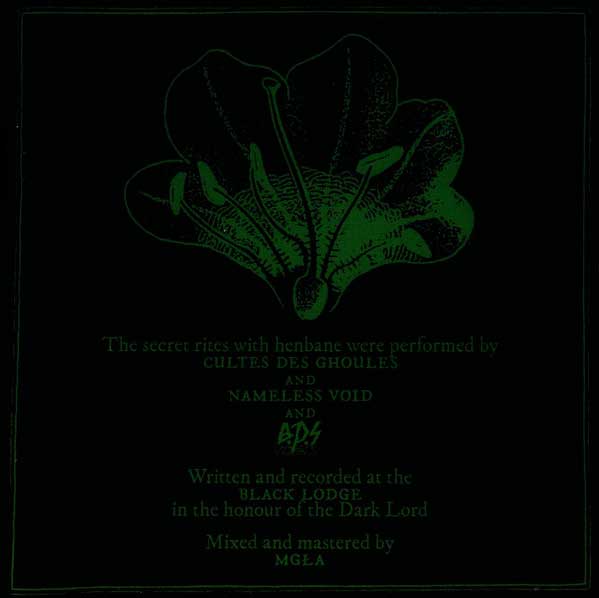Cultes des Ghoules
2024-05-15
by Niklas Göransson
Come, the blessed madness; Polish black metal sectarians Cultes des Ghoules are approaching two decades of graveyard sorcery and diabolical craft. Mark of the Devil discusses treading the darker paths, antagonising at every step.

MARK OF THE DEVIL: Our drummer, Windom Earle, founded CULTES DES GHOULES with a local guitarist back in 2004. The latter wimped out and left the scene soon thereafter, so he was replaced by Machine. Around the same time, Machine contacted me because he liked my ‘zine.
In the early and mid-2000s, Mark of the Devil, or Marek, edited a fanzine called Ritual Murder, publishing six issues in total. After some correspondence, Machine and Marek began meeting up at black metal concerts.
MARK OF THE DEVIL: One day in 2005, Machine gave me a rehearsal tape of raw and primitive black metal. It was poorly recorded, but I liked it! I could feel the filthy DARKTHRONE vibes, which was something that particularly interested me. In fact, I wasn’t the only one to recognise the band’s potential; those harsh recordings resulted in an EP offer from Sombre Records. Unfortunately, for obvious reasons, this never came to fruition.
Sombre Records was a German underground label responsible for many classic millennium-era black metal releases. The owner, Marcel ‘Darkmoon’ Spaller, died of a brain tumour in March 2006.
MARK OF THE DEVIL: I knew they were getting ready to record a demo, so when Machine asked if he could be a part of my ‘zine, I took the liberty of inviting myself into their band. We arranged a time to rehearse so I could try out; it sounded pretty lame, but I was nonetheless accepted. I guess I seemed cool and dedicated – and such qualities were deemed more important than my musical abilities, or lack thereof.
Marek grew up in Radom in east-central Poland, whereas his band mates – Windom Earle and Machine – are from Kielce, about an hour’s drive away.
MARK OF THE DEVIL: The geographical distance wasn’t a significant issue – frequent rehearsals didn’t feel like a necessity. We agreed from the beginning that CULTES DES GHOULES would never play live. As it turned out, we all shared the old-school view that musical skills aren’t the most important factor in a black metal context.
How was this mindset implemented in practice?
MARK OF THE DEVIL: For example, Windom Earle became so enamoured with this unconcerned attitude towards musicianship that he stopped rehearsing regularly. In essence, he sought a more primitive mode of expression. Similarly, Machine never practised more than was absolutely necessary.
How much did you rehearse before recording your 2006 demo, “Angel of Poison and Death”?
MARK OF THE DEVIL: That demo was only the second time I ever tried out my voice, the first having been my audition. Years earlier, I’d attempted to put something together with a few local guys, but it was a failure from day one. The project lacked integrity and was doomed to fail – sooner rather than later. None of us even knew how to set up the equipment, and we couldn’t finish a single song, so I never had the chance to practise.
CULTES DES GHOULES recorded their second demo, “Treading the Darker Paths”, the following year. I couldn’t find it online, which should come as no surprise since the tape was only printed in a handful of copies. However, I did come across a scan of the booklet and noted that it had no address for interested parties to send offers. Limited copies and devoid of contact details – some would argue that this defeats the purpose of a demo.
MARK OF THE DEVIL: “Treading the Darker Paths” was actually an aborted EP recording. Things went wrong, and the results were unsatisfactory. We immediately decided to try again at a later date. Meanwhile, we made a couple of tapes with improvised cover inserts meant only for a select few contacts. Sending them to labels would’ve been pointless since we already had a deal with Under the Sign of Garazel.
By then, Polish label Under the Sign of Garazel Productions had been active for a decade, working mainly with bands from the domestic scene.
MARK OF THE DEVIL: Tom, the label owner, offered to re-release “Angel of Poison and Death” on pro-cassette. After the tape came out in early 2007, he was so pleased with the reception that the next proposal for an EP came naturally. Under the Sign of Garazel has always been a well-respected name in the Polish underground, so his support meant a lot to us.
Did you hear from any other labels?
MARK OF THE DEVIL: Yes, a few reached out – so I guess contacting us wasn’t that difficult after all. Our approach might seem outdated or strange to modern listeners, but one should keep in mind that when destiny is at work, there’s little need for complex promotional tactics.
Meanwhile, a well-meaning friend of the band thought he was doing them a favour by setting up a CULTES DES GHOULES profile on Metal Archives, complete with personal information and connections never intended for public consumption.
MARK OF THE DEVIL: Now, a century and a half later, I find all this hilarious – but back then, we were pissed off. The other two guys had already been storming the underground with another band, and it was of utmost importance to them that CULTES DES GHOULES did not become regarded as a mere side-project.
This policy remains, which is why they insist that the other band involving Windom Earle and Machine is not mentioned in the same context as CULTES DES GHOULES.
MARK OF THE DEVIL: Our mutual taste for mystique likely played a role, too. But along comes this fella: ‘Hey guys, I just added all your personal details to Metal Archives. Don’t thank me too much!’ ‘Well, buddy, this wasn’t what we wanted for our band – you should have asked first.’ There was no way to reverse it, so we’ve since done our best to mess with the ‘official info’.
These countermeasures have resulted in a number of persistent misunderstandings. So, to clarify, CULTES DES GHOULES’ original core line-up – consisting of Mark of the Devil, Machine and Windom Earle – remains intact to this day.
In December 2007, Under the Sign of Garazel released the trio’s “Odd Spirituality” EP.
MARK OF THE DEVIL: “Odd Spirituality” perfectly captured our mood at the time; we were excited as hell. At this point, the band rehearsed in a massive, abandoned factory, which gave us an incredible feeling. The title track was intended as a hymn, or an oath. I penned the lyrics, and Windom Earle wrote the music – his inaugural and final composition for CULTES DES GHOULES. This was also the first time I attempted the inverted breath technique, but I never fully mastered it.
“Odd Spirituality” is where we find the early seedlings of CULTES DES GHOULES’ distinct sound, in mood and atmosphere as much as the music: morbid, weird, and macabre.
MARK OF THE DEVIL: The third recording was a significant improvement over the previous two. However, I never considered anything we released to be ‘special’. Those aspects never mattered much to me – or to anyone else involved. Our most important principles are to remain uncompromising and keep outdoing ourselves, nothing else. Want to know what I personally think of trying to be original? Let me quote C.S. Lewis on this:
Even in literature and art, no man who bothers about originality will ever be original: whereas if you simply try to tell the truth (without caring twopence how often it has been told before) you will, nine times out of ten, become original without ever having noticed it.
CULTES DES GHOULES’ recorded their debut album, “Häxan, …or Medieval Witchcraft and Infanticide…”, during the first half of 2008. What at its core sounds like a fusion of MAYHEM’s “De Mysteriis Dom Sathanas”, BEHERIT’s “Drawing Down the Moon”, early BARATHRUM, and MORTUARY DRAPE builds further on the musical foundations cemented with “Odd Spirituality”.
MARK OF THE DEVIL: That was probably the most intense period of our ‘career’. We rehearsed a lot, like every two or three weeks, and really got to know each other, leading to some crazy and funny situations. All of us were learning new things – musically speaking. As for influences, I can’t pinpoint anything specific; we just made music. If a riff sounded like another band, it didn’t really bother us.
The “Medieval Witchcraft and Infanticide…” part of the title reminds me of a mid-90s interview with Samoth. The EMPEROR guitarist lamented the new philosophical take on black metal Satanism and instead called for a primal devil-worship styled after medieval practices, exemplified by witches sacrificing infants.
MARK OF THE DEVIL: I doubt we read that interview, but we were aware of the concept. Did it influence us? I can’t say for sure, but we certainly took the Devil very seriously. We wanted as Satanic a sound as possible, leaving no doubts about our true nature or intentions – and extreme imagery was needed to achieve that. To us, it became a personal statement: CULTES DES GHOULES has nothing to do with any of the ‘artsy’ bands plaguing the scene.
“Baptised by Barron” – is that a homage to Gilles de Rais?
MARK OF THE DEVIL: Yes. That’s one of Machine’s lyrics; he has a soft spot for this character. Gilles de Rais is almost like his patron saint. Machine was also responsible for “The Covenant and the Sacrifice”, whereas I wrote the remaining three lyrics.
Under the Sign of Garazel Productions released “Häxan, …or Medieval Witchcraft and Infanticide…” on CD in November 2008.
MARK OF THE DEVIL: Shortly after the CD release, the guy from Of Crawling Shadows Records approached us about a vinyl edition. We were bursting with pride; at that time, not many Polish bands had the opportunity to release their work on the LP format, and this kick-started a lasting friendship.
Concurrently, CULTES DES GHOULES recorded three tracks for an October 2009 split tape with GOAT TYRANT titled “Conjurers of Archaic Powers”.
MARK OF THE DEVIL: “Conjurers of Archaic Powers” was our maiden voyage into truly experimental territory, like the track “A View of An Open Grave”, which we intended as a NECROMANTIA tribute. The first time we rehearsed this song, it was just the drummer and me – no guitars. Regrettably, that recording has been lost. Some of the lyrics draw from what you might call ‘real-life experiences’. The other members aren’t particularly pleased with this EP, so my suggestions to re-issue it never fell on eager ears.
In January 2011 came “Ridden with Holy Grace”, a split seven-inch alongside SZRON. Then, in August that year, a new mini-CD presented CULTES DES GHOULES’ most ambitious work to date – a twenty-five-minute track titled “Spectres over Transylvania”.
MARK OF THE DEVIL: Both are solid recordings, each revealing the gradual progression of our sound. For “Spectres over Transylvania”, we’d decided to compose a lengthy piece of music. Tasked with writing suitable lyrics, I took the opportunity to explore the gothic style – as a tribute to the archaic traits and themes found in many 80s and 90s bands. One source of inspiration was Werner Herzog’s Nosferatu; I tried to capture the atmosphere of that movie.
These early releases were all recorded and mixed ‘at Black Lodge in honour of the Dark Lord’. I’m assuming Black Lodge is some kind of semi-professional home studio setup.
MARK OF THE DEVIL: Yes, that’s right – and it wasn’t even the same location. For many years, CULTES DES GHOULES’ main rehearsal spot was in a tiny, smelly backroom in the garage under our drummer’s house. Thankfully, that horrible place no longer exists. Black Lodge was meant to represent a state of mind rather than a specific recording setup. Needless to say, its name is a tribute to Twin Peaks.
In January 2013, CULTES DES GHOULES released their second album, “Henbane, …or Sonic Compendium of the Black Arts”. Compared to “Häxan”, the production is a massive improvement. The vocals are not only more competently performed but also sound much better in the mix.
MARK OF THE DEVIL: This time, Under the Sign of Garazel gave us a studio budget so we could finally afford a decent microphone. We recorded everything at Black Lodge, and then Mikołaj of MGŁA mixed and mastered it at No Solace Studio – under our watchful eyes, of course. The band still rehearsed regularly in those days… like, once per month. CULTES DES GHOULES was formed to create, not to ‘jam’. Therefore, we can take it easy and even play a bit sloppy; we only need to hear how the riffs sound with drums and vocals.
The lyrics are a huge step forward from “Häxan” – you must have had plenty of practice.
MARK OF THE DEVIL: I’d just graduated from an English course after three years of intense work. Of course, this helped me write material of higher quality; more profound, so to speak. I owe a lot to the wider sources of inspiration that unfolded before me during my studies.
In the more personal CULTES DES GHOULES feature in Bardo Methodology #8, Marek described how a whole new world of esoteric literature became available to him once he’d mastered the English language.
MARK OF THE DEVIL: I believe I fell into some kind of trance state while working on “Henbane”. It wasn’t a strong feeling; I only realised this afterwards. When I’d completed five lyrics, we started composing the material. However, I felt a constant, gnawing unease – as if something was missing. Finally, one day, I sat down and wrote “The Devil Intimate”, which satiated my urge to write lyrics in Polish.
Was it a big difference from English?
MARK OF THE DEVIL: Yes, writing lyrics in English is easier than using my native tongue. Once I’d finished it, I felt a remarkable relief, a physical alleviation, as if something had released me from its grip. Imagine that you fully inhale and hold your breath until your face turns blue… and then exhale – but in a more spiritual way. Only then did our work feel complete. After this, I couldn’t write anything new for a very long time.

CULTES DES GHOULES ended up discarding one of the songs, “Ageless Malediction”, because it didn’t fit the overall flow of “Henbane”.
Another notable development on this album was the inclusion of Nameless Void from US black metal band NEGATIVE PLANE. After contributing some synthesisers on “Henbane”, he joined CULTES DES GHOULES on bass guitar.
MARK OF THE DEVIL: None of us knew him when we recorded “Henbane”. Two of the songs needed some keyboard ornaments, and I became fixated on the idea that Nameless Void was the man for the job. I sent him an email introducing the band and our concept and asked if he wanted to contribute. NEGATIVE PLANE played a festival in Prague a few months later, so we all met in person and really enjoyed each other’s company.
Does he take part in the creative process?
MARK OF THE DEVIL: Yes, but we rehearse separately. The three of us in Poland create rough recordings, which are then sent to Void so he can write the basslines. He typically spends his summer holidays in Europe, enabling us to arrange No Solace sessions for him to record bass.
“Henbane” opened many people’s eyes to CULTES DES GHOULES, resulting in a rapid increase of back-catalogue sales – so much so that “Spectres Over Transylvania” had to be reprinted.
MARK OF THE DEVIL: We knew CULTES DES GHOULES had amassed a following but were unaware of the full extent. At least I was, but this changed once I started noticing reviews and discussions online. We were quite surprised, especially since “Henbane” was meant to sound controversial – or at least strange.
In what regard?
MARK OF THE DEVIL: For instance, during the writing process, we became obsessed with doom metal and eagerly incorporated many such elements into our new material. We anticipated a major outcry from scene purists; in fact, we looked forward to it. However, this expectation failed miserably, as the album somehow became a bestseller. Well… ‘Next time’, we told ourselves.
They made a valiant attempt with “The Rise of Lucifer”, an EP released in May 2015. It was reportedly recorded and mixed in identical fashion to “Henbane”, yet the sound is comparatively poor.
MARK OF THE DEVIL: Nonsense, the sound is great! It just wasn’t what everyone expected. One could say that we were playing a game with our listeners; we have been ever since “Henbane”. After the Black Lodge session, “The Rise of Lucifer” was finalised at Mikołaj’s old place: the basement of some abandoned, dilapidated hotel near the Kraków city centre. Truly ‘cosy’ place – great atmosphere.
Production issues aside, the actual music sounds stellar. The NECROMANTIA cover is excellent and gives me better insight into CULTES DES GHOULES’ approach to bass guitar.
MARK OF THE DEVIL: That cover did indeed hint at the band’s origins, which was also our intention. NECROMANTIA holds a special place in our pantheon of musical gods. I remember feeling something magical in the air when my vocal session for this song began.
Shortly after the EP recording – well into the composition process for their third album – Marek left CULTES DES GHOULES.
During his temporary departure, Marek mentioned these recent turn of events to a Finnish contact. Years later, this email ended up on the Nuclear War Now! forum, causing quite a stir. First of all, what kind of prick leaks private correspondence on a public forum?
MARK OF THE DEVIL: Nah, it doesn’t matter who that was. I wasn’t even pissed off – just a bit dismayed, maybe. And regarding my leave of absence: we were simply fed up with one another.
Luckily, the Polish trio mended relations and resumed their collaboration. With the October 2016 release of “Coven, or Evil Ways Instead of Love” – courtesy of Hells Headbangers Records, Under the Sign of Garazel, and Of Crawling Shadows – CULTES DES GHOULES delivered a psychotically ambitious musical epos.
MARK OF THE DEVIL: Yes, our fanbase was confused – and confused hard. “Coven” came in really heavy. This album is total; it’s complete. It embodies not just our personal music preferences but also the attitude and philosophy of CULTES DES GHOULES: always walking against the tide, antagonising at every step of the way.
I’d wager that very few listeners drawn in by “Henbane” were expecting anything resembling a ‘black metal opera’ – a term I’ve seen used for this record, and not without warrant.
MARK OF THE DEVIL: That wasn’t our invention; I don’t even recall hearing this description myself. Nevertheless, I assume whoever coined it sensed where the basic idea came from… namely, the second MASTER’S HAMMER album, which was advertised as a ‘black metal operetta’, making the analogy obvious. “The Jilemnice Occultist” was the first black metal cassette I ever heard – its significance and impact are immeasurable, and this influence had to manifest somehow.
The album closer – “Satan, Father, Savior, Hear My Prayer… (Scene V)” – clocks in at an impressive twenty-eight minutes. The song’s arrangement is unconventional, to say the least; it’s structured more like an epic film score than a typical metal song.
MARK OF THE DEVIL: I only contributed the words, so I have no idea what Machine was thinking when he prepared the raw arrangements. As always, I wrote the lyrics first, and the music followed. Machine generally refuses to start a song until he’s read the narrative. But he’d sure as hell evolved as a composer; that track was his creative pinnacle of this era.
Marek told me that four rehearsals were enough to ‘complete the material’. With a playing time of an hour and forty minutes, I don’t see how this is even possible – assuming each session didn’t last several days.
MARK OF THE DEVIL: No, not at all. We never play longer than two to three hours at a time. In making this album, we mastered an efficient working style – our magic formula, if you will. It brings me great joy to consider how effortlessly everything came together… that is, once the lyrics were ready.
Was this a lengthy process?
MARK OF THE DEVIL: Very much so. The concept was a work in progress for ages, and I completed several rough drafts. But in the meantime, other texts kept coming to me out of the blue – material I believed album-worthy. However, Machine disagreed; he was firmly set on “Coven” and said he’d rather wait for years than do anything else.
I must say, I’m grateful for Machine’s persistence. The “Coven” lyrics boast some of the most impressive writing I’ve seen in a black metal context.
MARK OF THE DEVIL: It was gruelling work – developing the idea, hammering out the details, and then putting everything on paper. But once all the pieces had fallen into place in my head, the actual writing process went surprisingly fast; from a few scattered notes to the final texts being penned in a fiery state of mind one evening.
As per usual, CULTES DES GHOULES recorded drums and guitars at Black Lodge – but the vocals and bass were laid down at No Solace. Marek had two days for the oration, whereas Nameless Void tracked his basslines in just a few hours.
MARK OF THE DEVIL: I usually deliver in one day, but “Coven” took me a bit longer: seven hours non-stop during the first session and then three to four the next day. Mikołaj is a fantastic producer, always extremely focused. I think he became really engrossed in the album, even more so than in our previous collaborations.
Throughout the many iterations of No Solace Studio, Mikołaj Żentara has created several unique-sounding productions. Besides CULTES DES GHOULES and his own work with MGŁA, INFERNAL WAR’s “Axiom” and ARMAGEDDA’s “Svindeldjup ättestup” come to mind.
MARK OF THE DEVIL: Normally, we dislike having visitors in the studio – but the “Coven” session at No Solace felt like a celebration. Many of our closest friends were present, acting out small roles here and there as guest vocalists. I recorded my parts in the sequence they appear on the album, which is the same order all songs and scenes were composed. One could say we fully enacted this concept.
Given the theatrical nature of Marek’s performance, I was surprised to learn that his vocal deliveries were largely improvised. I first assumed the different voices and techniques had been arranged and planned beforehand.
MARK OF THE DEVIL: No, I hardly ever practise in advance. When we rehearse, it’s solely to compose and arrange – nothing more. Our main focus is often on the drums. During a recording, there’s usually no time for repeated attempts; at least not for me, heh. Consequently, many vocal parts were entirely intuitive.
So, instead of memorising the lyrics beforehand, you just read them and ad-libbed to the music?
MARK OF THE DEVIL: More or less. I generally followed either the drum patterns or Machine’s guitar melodies. Sometimes, specific words or phrases required a different approach, but all these nuances were completely unrehearsed. Often, finding my way blindly is how I discover new capabilities. And whatever I lack in practise, I compensate with theatrics and emotion.
log in to keep reading
The second half of this article is reserved for subscribers of the Bardo Methodology online archive. To keep reading, sign up or log in below.
